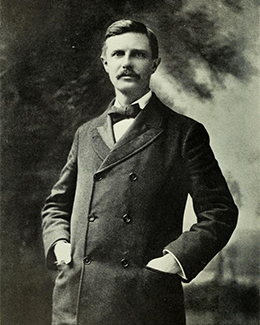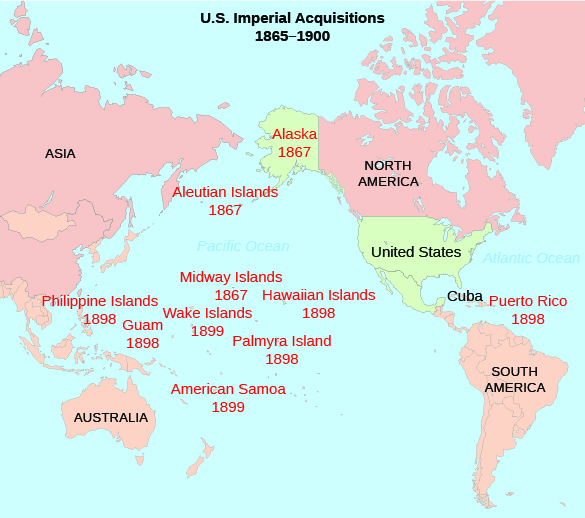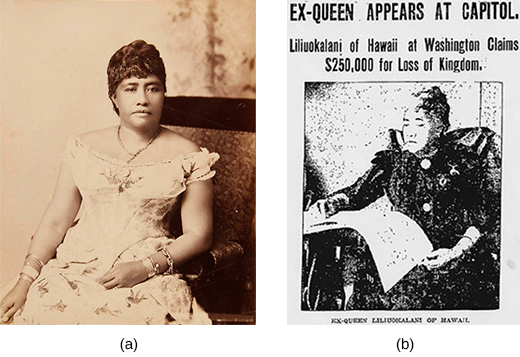| << Chapter < Page | Chapter >> Page > |

Although there was no more room for these forces to proceed domestically, they would continue to find an outlet on the international stage. Turner concluded that “the demands for a vigorous foreign policy, for an interoceanic canal, for a revival of our power upon our seas, and for the extension of American influence to outlying islands and adjoining countries are indications that the forces [of expansion] will continue.” Such policies would permit Americans to find new markets. Also mindful of the mitigating influence of a frontier—in terms of easing pressure from increased immigration and population expansion in the eastern and midwestern United States—he encouraged new outlets for further population growth, whether as lands for further American settlement or to accommodate more immigrants. Turner’s thesis was enormously influential at the time but has subsequently been widely criticized by historians. Specifically, the thesis underscores the pervasive racism and disregard for the indigenous communities, cultures, and individuals in the American borderlands and beyond.
Explore the controversy associated with Turner’s Frontier Thesis at U.S. History Scene.
While Turner provided the idea for an empire, Mahan provided the more practical guide. In his 1890 work, The Influence of Seapower upon History , he suggested three strategies that would assist the United States in both constructing and maintaining an empire. First, noting the sad state of the U.S. Navy, he called for the government to build a stronger, more powerful version. Second, he suggested establishing a network of naval bases to fuel this expanding fleet. Seward’s previous acquisition of the Midway Islands served this purpose by providing an essential naval coaling station, which was vital, as the limited reach of steamships and their dependence on coal made naval coaling stations imperative for increasing the navy’s geographic reach. Future acquisitions in the Pacific and Caribbean increased this naval supply network ( [link] ). Finally, Mahan urged the future construction of a canal across the isthmus of Central America, which would decrease by two-thirds the time and power required to move the new navy from the Pacific to the Atlantic oceans. Heeding Mahan’s advice, the government moved quickly, passing the Naval Act of 1890, which set production levels for a new, modern fleet. By 1898, the government had succeeded in increasing the size of the U.S. Navy to an active fleet of 160 vessels, of which 114 were newly built of steel. In addition, the fleet now included six battleships, compared to zero in the previous decade. As a naval power, the country catapulted to the third strongest in world rankings by military experts, trailing only Spain and Great Britain.

The United States also began to expand its influence to other Pacific Islands, most notably Samoa and Hawaii. With regard to the latter, American businessmen were most interested in the lucrative sugar industry that lay at the heart of the Hawaiian Islands’ economy. By 1890, through a series of reciprocal trade agreements, Hawaiians exported nearly all of their sugar production to the United States, tariff-free. When Queen Liliuokalani tapped into a strong anti-American resentment among native Hawaiians over the economic and political power of exploitative American sugar companies between 1891 and 1893, worried businessmen worked with the American minister to Hawaii, John Stevens, to stage a quick, armed revolt to counter her efforts and seize the islands as an American protectorate ( [link] ). Following five more years of political wrangling, the United States annexed Hawaii in 1898, during the Spanish-American War.

The United States had similar strategic interests in the Samoan Islands of the South Pacific, most notably, access to the naval refueling station at Pago Pago where American merchant vessels as well as naval ships could take on food, fuel, and supplies. In 1899, in an effort to mitigate other foreign interests and still protect their own, the United States joined Great Britain and Germany in a three-party protectorate over the islands, which assured American access to the strategic ports located there.
In the last decades of the nineteenth century, after the Civil War, the United States pivoted from a profoundly isolationist approach to a distinct zeal for American expansion. The nation’s earlier isolationism originated from the deep scars left by the Civil War and its need to recover both economically and mentally from that event. But as the industrial revolution changed the way the country worked and the American West reached its farthest point, American attitudes toward foreign expansion shifted. Businesses sought new markets to export their factory-built goods, oil, and tobacco products, as well as generous trade agreements to secure access to raw materials. Early social reformers saw opportunities to spread Christian gospel and the benefits of American life to those in less developed nations. With the rhetoric of Fredrick J. Turner and the strategies of Alfred Mahan underpinning the desire for expansion abroad, the country moved quickly to ready itself for the creation of an American empire.

Notification Switch
Would you like to follow the 'U.s. history' conversation and receive update notifications?